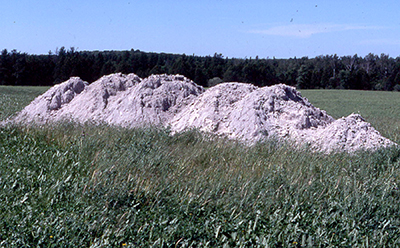Selecting a liming material – Part 1
Where practical options are available, make your choice of liming material based on solid, research-based information.

For many Michigan farmers in areas with lower soil pH, different options for liming materials exist. These choices may include “ag lime” (crushed calcitic limestone), dolomitic lime (high in magnesium), slaked lime (“quicklime” or “burnt lime”), marl, sugarbeet lime, industrial wood ash and other industrial by-products with lime equivalent. Unless a low-cost, local source of good quality ag lime or suitable industrial by-product is available, a decision must be made about the most desirable type and form of lime to purchase and use. Michigan State University Extension bulletin E0471, “Lime for Michigan Soils,” is an excellent source of information.
If pH and soil magnesium levels are low, then dolomitic lime is a good option to address both issues. Even where soil magnesium is adequate or high, dolomitic lime should still be considered if it is the most economical alternative.
The most important factors affecting the quality of agricultural liming materials manufactured from crushed limestone are fineness of grind and the purity of the limestone used. Lime particles coarser than 8-mesh screen (approximately 0.125 inch) have no practical liming effectiveness. Particles passing through a 60-mesh screen have 100 percent effectiveness. Those in between are considered 50 percent effective. “Neutralizing value” is a chemical measurement of the lime materials ability to neutralize acid. Lime recommendations are usually given assuming a neutralizing value of 90 (90 percent equivalent of pure calcium carbonate).
Calculations using the fineness factor and the neutralizing value are used to generate an “effective calcium carbonate” number for commercial liming materials. A high effective calcium carbonate results in a lower recommendation of lime than what may appear on a soil test report, while low effective calcium carbonate will result in the need for more lime that the soil test report recommends. Generally, after liming materials are applied, the soil pH will typically increase during the first one to two years and then plateau.
Liquid lime, or “lime suspension,” is a liming option where available commercially. It has advantages and disadvantages. However, be aware there is nothing special about the liming effectiveness of lime suspensions. Their advantages include fast soil reaction, no dust, ability to combine with liquid fertilizers except for phosphorus and ease of uniform application. Disadvantages include the potential need for annual application, potential for higher cost than conventional liming and difficulty in getting large pH changes with relatively light applications of lime. Liquid lime contains very finely ground limestone, a small amount of clay and dispersing agent.
Pelletized lime also consists of very finely ground limestone particles held together by a soluble binding agent. The resulting product is easier to spread and less dusty than regular ground limestone. Pelletized lime has been widely adopted in the lawn and garden sector, but its relatively high cost has limited widespread use in agriculture. Again, there is nothing special about the effectiveness of pelletized lime. Its advantages are found in convenience and ease of spreading. It is a source of high quality lime and can be blended with dry fertilizers. Disadvantages include higher cost than traditional calcitic or dolomitic lime. Also, the liming effect is localized in the area around the granule or pellet.

Industrial wood ash ready for application.
Other liming materials should be analyzed for neutralizing value and fineness, if appropriate. Some, such as industrial wood ash, may include plant nutrients in addition to providing liming function. Paper mill sludges vary depending on the source, but generally provide around 10 percent lime equivalent by dry weight and include clay and organic material.
Part 2 of this article focuses on an Upper Peninsula trial to demonstrate differences in locally available liming materials.



 Print
Print Email
Email


